Current Trends and Future Scenarios: Modeling Maximum River Discharge in the Zhaiyk–Caspian Basin (Kazakhstan) Under a Changing Climate
Abstract
1. Introduction
2. Materials and Methods
2.1. Study Area
2.2. Input Data
- –
- I—left-bank tributaries of the Zhaiyk River (Or, Elek, Ulken Kobda, Shyngyrlau, Kargaly, Kosestek, Aktasty, etc.);
- –
- II—rivers in the western part of the Obshchy Syrt (Shagan, Derkul, Shyzhyn 1, Shyzhyn 2);
- –
- IV—rivers flowing from the southern part of the Podural Plateau (Olenty, Kupirankaty, Buldurty, Shiderty);
- –
- V—southern rivers (Oyil, Sagyz, Zhem).
- –
- GFDL-ESM4 (NOAA Geophysical Hydrodynamics Laboratory, USA);
- –
- IPSL-CM6A-LR (Pierre-Simon Laplace Institute, France);
- –
- MPI-ESM1-2-HR (Max Planck Institute for Meteorology, Germany);
- –
- MRI-ESM2-0 (Meteorological Research Institute, Japan);
- –
- UKESM1-0-LL (Hadley Centre for Meteorological Forecasting, United Kingdom).
2.3. Research Methods
- –
- total precipitation during the cold period (September–March), reflecting the degree of autumn soil moisture and snow accumulation ();
- –
- average air temperature in the period from June to October, determining the water absorption capacity and evaporation losses of the soil layer ();
- –
- average winter temperature, affecting the frequency of thaws and the intensity of early snowmelt ().
3. Results
3.1. Contemporary Changes in the Characteristics of Spring Floods
3.2. Contemporary Changes in Climatic Factors Affecting Maximum Runoff
3.3. Scenario-Based Forecasting of Maximum River Discharge
4. Discussion
5. Conclusions
Author Contributions
Funding
Data Availability Statement
Conflicts of Interest
References
- Makhmudova, L.; Moldakhmetov, M.; Mussina, A.; Kurmangazy, E.; Kambarbekov, G.; Zharylkassyn, A.; Zhulkainarova, M. Study of water stress in plains rivers: Climate and human influence. Evergreen 2024, 11, 1530–1543. [Google Scholar] [CrossRef]
- Smagulov, Z.; Makhmudova, L.; Alimkulov, S.; Talipova, E.; Zagidullina, A.; Birimbayeva, L.; Sailaubek, A. Transformation of seasonal distribution of river flow in the Zhaiyk-Caspian water basin under changing climate conditions. J. Water Clim. Change 2025, 16, 400–429. [Google Scholar] [CrossRef]
- Overview of the Climate Features on the Territory of Kazakhstan. Available online: https://www.kazhydromet.kz/ru/klimat/obzor-ob-osobennostyah-klimata-na-territorii-kazahstana (accessed on 13 October 2025).
- Tursunova, A.; Nurbatsina, A.; Salavatova, Z.; Huthoff, F. Sustainability challenges in Kazakhstan’s river systems: Assessing climate-induced hydrological changes. Sustainability 2025, 17, 3405. [Google Scholar] [CrossRef]
- Jiang, T.; Su, B.; Hartmann, H. Temporal and spatial trends of precipitation and river flow in the Yangtze River Basin, 1961–2000. Geomorphology 2007, 85, 143–154. [Google Scholar] [CrossRef]
- Shiklomanov, A.I.; Lammers, R.B.; Rawlins, M.A.; Smith, L.C.; Pavelsky, T.M. Temporal and spatial variations in maximum river discharge from a new Russian data set. J. Geophys. Res. 2007, 112, G04S53. [Google Scholar] [CrossRef]
- Dankers, R.; Feyen, L. Climate change impact on flood hazard in Europe: An assessment based on high-resolution climate simulations. J. Geophys. Res. 2008, 113, D19105. [Google Scholar] [CrossRef]
- Ye, X.; Xu, Y.-P.; Booij, M.J. Impact assessment of multiple uncertainty sources on high flows under climate change. Hydrol. Res. 2015, 47, 61–74. [Google Scholar] [CrossRef]
- Meresa, H.; Murphy, C.; Fealy, R.; Golian, S. Uncertainties and their interaction in flood hazard assessment with climate change. Hydrol. Earth Syst. Sci. 2021, 25, 5237–5257. [Google Scholar] [CrossRef]
- Gao, C.; Booij, M.J.; Xu, Y.-P. Assessment of extreme flows and uncertainty under climate change: Disentangling the uncertainty contribution of representative concentration pathways, global climate models and internal climate variability. Hydrol. Earth Syst. Sci. 2020, 24, 3251–3269. [Google Scholar] [CrossRef]
- Alexandre, D.A.; Chaudhuri, C.; Gill Fortin, J. Novel extensions to the Fisher copula to model flood spatial dependence over North America. Hydrol. Earth Syst. Sci. 2024, 28, 5069–5089. [Google Scholar] [CrossRef]
- Willkofer, F.; Wood, R.R.; Ludwig, R. Assessing the impact of climate change on high return levels of peak flows in Bavaria applying the CRCM5 large ensemble. Hydrol. Earth Syst. Sci. 2024, 28, 2969–2989. [Google Scholar] [CrossRef]
- Görgen, K.; Beersma, J.; Brahmer, G.; Buiteveld, H.; Carambia, M.; de Keizer, O.; Krahe, P.; Nilson, E.; Lammersen, R.; te Linde, A.; et al. Assessment of Climate Change Impacts on Discharge in the Rhine River Basin: Results of the RheinBlick2050 Project; International Commission for the Hydrology of the Rhine Basin (CHR): Lelystad, The Netherlands, 2010. [Google Scholar]
- Frolova, N.L.; Agafonova, S.A.; Kireeva, M.B.; Povalishnikova, E.S.; Pakhomova, O.M. Recent changes of annual flow distribution of the Volga Basin rivers. Geogr. Environ. Sustain. 2017, 10, 28–39. [Google Scholar] [CrossRef]
- Wang, P.; Shpakova, R.N. Complex streamflow responses to climate warming in five river basins in South Yakutia, Russia. Front. Environ. Sci. 2022, 10, 1033943. [Google Scholar] [CrossRef]
- Medvedev, A.I. Bayesian Estimates of Changes in the Runoff of Russian Rivers in the XXI Century Based on CMIP6. Izv. Atmos. Ocean. Phys. 2024, 60, 135–156. (In Russian) [Google Scholar] [CrossRef]
- Sapozhnikova, A.A.; Gorelits, O.V. Characteristics of Long-Term and Seasonal Runoff Variability at the Head of the Mouth Area of the Onega River. Water Resour. 2025, 52, 18–32. (In Russian) [Google Scholar] [CrossRef]
- Stahl, K.; Hisdal, H.; Hannaford, J.; Tallaksen, L.M.; Van Lanen, H.A.J.; Sauquet, E.; Demuth, S.; Fendekova, M.; Jódar, J. Streamflow Trends in Europe: Evidence from a Dataset of Near-Natural Catchments. Hydrol. Earth Syst. Sci. 2010, 14, 2367–2382. [Google Scholar] [CrossRef]
- Magritsky, D.V.; Evstigneev, V.M.; Yumina, N.M.; Toropov, P.A.; Kenzhebaeva, A.; Ermakova, G.S. Changes of Runoff in the Ural River Basin. Mosc. Univ. Bulletin. Ser. 5 Geogr. 2018, 1, 90–101. Available online: https://vestnik5.geogr.msu.ru/jour/article/view/389/370?locale=ru_RU (accessed on 5 May 2025). (In Russian).
- Yumina, N.M.; Kozlov, M.O. Analysis of Long-Term Variability of River Runoff in the Ural River Basin. Eurasian Union Sci. 2021, 5, 8–11. (In Russian) [Google Scholar] [CrossRef]
- Sivokhip, Z.T.; Pavleychik, V.M. Current Trends in the Intra-Annual Distribution of River Runoff in the Ural River Basin. Bull. Irkutsk State Univ. Ser. Earth Sci. 2020, 33, 112–123. (In Russian) [Google Scholar] [CrossRef]
- Sivokhip, Z.T.; Pavleychik, V.M.; Padalko, Y.A. Changes in Low Flow in the Ural River Basin. Bull. Russ. Acad. Sci. Geogr. Ser. 2021, 85, 900–913. (In Russian) [Google Scholar] [CrossRef]
- Medeu, A.R.; Makhmudova, L.K.; Myrzakhmetov, A.B.; Zagidullina, A.R.; Kanai, M.A. Flood Situation on the Zhaiyk (Ural) River in 2024. Geogr. Water Resour. 2024, 4, 14–23. (In Russian) [Google Scholar] [CrossRef]
- Tursunova, A.A.; Myrzakhmetov, A.B.; Baspakova, G.R.; Sailaubek, A.M.; Salavatova, Z.T. Historical Overview of Hydrological Characteristics of Floods on the Zhaiyk River. Geogr. Water Resour. 2024, 2, 40–51. (In Russian) [Google Scholar] [CrossRef]
- Terekhov, A.G.; Sairov, S.B.; Abaev, N.N.; Sagatdinova, G.N.; Amirgaliev, E.N. On Possible Causes of Exceptionally Large Spring Floods in Kazakhstan in 2024. Curr. Probl. Remote Sens. Earth Space 2024, 21, 331–338. (In Russian) [Google Scholar] [CrossRef]
- ReliefWeb. Devastating Floods in Kazakhstan: A National Emergency. ReliefWeb, 12 June 2024. Available online: https://reliefweb.int/report/kazakhstan/devastating-floods-kazakhstan-national-emergency (accessed on 18 August 2025).
- ACAPS. Kazakhstan: Floods Briefing Note. ACAPS, 23 April 2024. Available online: https://www.acaps.org/fileadmin/Data_Product/Main_media/20240423_ACAPS_briefing_note_Kazakhstan_floods.pdf (accessed on 18 August 2025).
- Danilovich, I.S.; Loginov, V.F.; Groisman, P.Y. Changes of Hydrological Extremes in the Center of Eastern Europe and Their Plausible Causes. Water 2023, 15, 2992. [Google Scholar] [CrossRef]
- Laiskhanov, S.; Sharapkhanova, Z.; Myrzakhmetov, A.; Levin, E.; Taukebayev, O.; Nurmagambetuly, Z.; Kaster, S. Geo-Ecological Analysis of the Causes and Consequences of Flooding in the Western Region of Kazakhstan. Urban Sci. 2025, 9, 20. [Google Scholar] [CrossRef]
- Dottori, F.; Szewczyk, W.; Ciscar, J.-C.; Zhao, F.; Alfieri, L.; Hirabayashi, Y.; Bianchi, A.; Mongelli, I.; Frieler, K.; Betts, R.A.; et al. Increased Human and Economic Losses from River Flooding with Anthropogenic Warming. Nat. Clim. Change 2018, 8, 781–786. [Google Scholar] [CrossRef]
- Michalek, A.T.; Villarini, G.; Kim, T.; Quintero, F.; Krajewski, W.F.; Scoccimarro, E. Evaluation of CMIP6 HighResMIP for Hydrologic Modeling of Annual Maximum Discharge in Iowa. Water Resour. Res. 2023, 59, e2022WR034166. [Google Scholar] [CrossRef]
- Suram, A.; Anand, R.P.; Vema, V.K. Catchment Response to Climate Change under CMIP6 Scenarios: A Case Study of the Krishna River Basin. J. Water Clim. Change 2024, 15, 476–498. [Google Scholar] [CrossRef]
- Wu, Y.; Miao, C.; Fan, X.; Gou, J.; Zhang, Q.; Zheng, H. Quantifying the Uncertainty Sources of Future Climate Projections and Narrowing Uncertainties with Bias Correction Techniques. Earth’s Future 2022, 10, e2022EF002963. [Google Scholar] [CrossRef]
- Shukla, R.; Khare, D.; Kumar Dwivedi, A.; Rudra, R.P.; Palmate, S.S.; Ojha, C.S.P.; Singh, V.P. Evaluation of Statistical Downscaling Model’s Performance in Projecting Future Climate Change Scenarios. J. Water Clim. Change 2023, 14, 3559–3595. [Google Scholar] [CrossRef]
- Long, T.-T.; Ngo-Duc, T.; Phan-Van, T.; Tran, H.; Trinh, T.; Pham-Quang, N.; Nguyen-Xuan, T.; Tran-Anh, Q.; Do, N.; Nguyen, T. Future Rainfall Projections for the Lower Mekong Basin Using CMIP6 Dynamical Downscaling. J. Water Clim. Change 2025, 16, 1863–1876. [Google Scholar] [CrossRef]
- Fallah, B.; Rostami, M.; Russo, E.; Harder, P.; Menz, C.; Hoffmann, P.; Didovets, I.; Hattermann, F.F. Climate Model Downscaling in Central Asia: A Dynamical and a Neural Network Approach. Geosci. Model Dev. 2025, 18, 161–180. [Google Scholar] [CrossRef]
- Riahi, K.; Van Vuuren, D.P.; Kriegler, E.; Edmonds, J.; O’Neill, B.C.; Fujimori, S.; Bauer, N.; Calvin, K.; Dellink, R.; Fricko, O.; et al. The Shared Socioeconomic Pathways and Their Energy, Land Use, and Greenhouse Gas Emissions Implications: An Overview. Glob. Environ. Change 2017, 42, 153–168. [Google Scholar] [CrossRef]
- Davletgaliev, S.K.; Alimkulov, S.K.; Talipova, E.K. The possibility to applying simulated series for compile scenario forecasting river runoff. Environ. Earth Sci. 2020, 79, 397. [Google Scholar] [CrossRef]
- Lavrov, S.A.; Kalyuzhnyi, I.L. Influence of Climate Change on Spring Flood Runoff and Its Formation Factors in the Volga River Basin. Water Manag. Russ. 2016, 6, 42–60. (In Russian) [Google Scholar] [CrossRef]
- Gelfan, A.N.; Frolova, N.L.; Magritskii, D.V.; Kireeva, M.B.; Grigor’ev, V.Y.; Motovilov, Y.G.; Gusev, E.M. Influence of Climate on Annual and Maximum River Runoff in Russia: Assessment and Forecast. Fundam. Appl. Climatol. 2021, 7, 36–77. Available online: http://downloads.igce.ru/journals/FAC/FAC_2021/FAC_2021_1/Gelfan_A_et_al_FAC_2021_1.pdf (accessed on 24 May 2025). (In Russian). [CrossRef]
- Zaikov, B.D.; Belinkov, S.Y.; Sokolovskiy, D.L.; Karpov, B.G. Average Long-Term River Runoff of the USSR; Hydrometeoizdat: Moscow, Russia, 1937; 77p. (In Russian) [Google Scholar]
- Frieler, K.; Lange, S.; Piontek, F.; Reyer, C.P.O.; Schewe, J.; Warszawski, L.; Zhao, F.; Chini, L.; Denvil, S.; Emanuel, K.; et al. Assessing the Impacts of 1.5 °C Global Warming—Simulation Protocol of the Inter-Sectoral Impact Model Intercomparison Project (ISIMIP2b). Geosci. Model Dev. 2017, 10, 4321–4345. [Google Scholar] [CrossRef]
- Davletgaliev, S.K.; Dostaeva, A.D. Restoration of spring runoff series of the rivers of the Zhaiyk–Caspian basin. Hydrometeorol. Ecol. 2014, 1, 88–95. (In Russian) [Google Scholar]
- Kuzmin, V.A.; Gavrilov, I.S. Assessment of anthropogenic and climatic impacts on river runoff formation. Proc. Russ. State Hydrometeorol. Univ. 2012, 29, 36–42. (In Russian) [Google Scholar]
- UNESCO. Hydrological Analogy: Methodological Approaches to River Flow Reconstruction; UNESCO: Paris, France, 1999; 54p. [Google Scholar]
- Perevedentsev, Y.P.; Tudrii, V.D.; Vereshchagin, M.A. Practical Guide to the Production of Primary Statistical Processing and Analysis of Meteorological Series; Kazan State University: Kazan, Russia, 2009; 34p. (In Russian) [Google Scholar]
- Polyak, I.I. Numerical Methods for Observation Analysis; Hydrometeoizdat: Leningrad, Russia, 1975; 211p. (In Russian) [Google Scholar]
- Sikan, A.V. Methods of Statistical Processing of Hydrometeorological Information; Russian State Hydrometeorological University (RSHU): St. Petersburg, Russia, 2007; 279p. (In Russian) [Google Scholar]
- Helsel, D.R.; Hirsch, R.M. Statistical Methods in Water Resources; U.S. Geological Survey Techniques and Methods, Book 4, Chap. A3; USGS: Reston, VA, USA, 2020. [Google Scholar] [CrossRef]
- Lavrov, S.A.; Kalyuzhnyi, I.L. Physical Processes and Patterns of Winter and Spring Runoff Formation in the Volga River Basin under Climate Change Conditions. Water Manag. Russ. 2012, 4, 74–84. Available online: https://waterjournal.ru/files/wj/1619070965.pdf (accessed on 24 June 2025). (In Russian).
- Georgievskii, V.Y.; Grek, E.A.; Grek, E.N.; Lobanova, A.G.; Molchanova, T.G. Assessment of current changes in maximum river runoff in Russia. Meteorol. Hydrol. 2019, 11, 46–55. Available online: https://elibrary.ru/item.asp?id=41550783 (accessed on 10 August 2025). (In Russian).
- Vladimirov, A.M. Factors determining occurrence of the high flow and highest water level during a flood. Sch. Notes Russ. State Univ. Humanit. 2009, 9, 22–39. Available online: http://elib.rshu.ru/files_books/pdf/9-3.pdf (accessed on 18 August 2025). (In Russian).
- Dmitrieva, V.A.; Nefedova, E.G. Hydrological response to changing climatic conditions and human activities in the Upper Don River basin. Probl. Geogr. Hydrol. Changes 2018, 145, 285–297. (In Russian) [Google Scholar]
- Barnett, T.P.; Adam, J.C.; Lettenmaier, D.P. Potential impacts of a warming climate on water availability in snow-dominated regions. Nature 2005, 438, 303–309. [Google Scholar] [CrossRef] [PubMed]
- Stewart, I.T.; Cayan, D.R.; Dettinger, M.D. Changes toward earlier streamflow timing across western North America. J. Clim. 2005, 18, 1136–1155. [Google Scholar] [CrossRef]
- Do, H.X.; Leonard, M.; Westra, S. A global-scale investigation of trends in annual maximum streamflow. J. Hydrol. 2017, 552, 28–43. [Google Scholar] [CrossRef]
- Gal’perin, R.I.; Kolcha, T.V.; Avezova, A. The Ural River: The risk of floods in the lower reaches under current conditions. Hydrometeorol. Ecol. 2008, 4, 155–165. (In Russian) [Google Scholar]
- Davletgaliev, S.; Baimakhan, Z. Calculation of spring runoff characteristics of rivers in the eastern part of the Caspian region. Hydrometeorol. Ecol. 2019, 3, 105–113. (In Russian) [Google Scholar]
- Sivokhip, Z.T.; Pavleychik, V.M.; Chibilev, A.A. Change in the river water regime of the Ural River Basin. Dokl. Earth Sci. 2019, 488, 1217–1221. [Google Scholar] [CrossRef]
- Moldakhmetov, M.M.; Makhmudova, L.K.; Kurmangazy, E. Statistical parameters of spring flood runoff time series of the Yesil River basin. Bull. KazNU. Geogr. Ser. 2020, 56, 39–49. Available online: https://bulletin-geography.kaznu.kz/index.php/1-geo/article/view/889 (accessed on 18 August 2025). (In Russian).
- Kalyuzhnyi, I.L.; Lavrov, S.A. Variability of frost depth in the Volga River basin and its impact on runoff formation in winter and spring under climate change. Russ. Meteorol. Hydrol. 2016, 41, 487–496. [Google Scholar] [CrossRef]
- Georgiadi, A.G.; Koronkevich, N.I.; Kashutina, E.A.; Barabanova, E.A. Natural-climatic and anthropogenic changes in the runoff of the Volga and Don rivers. Fundam. Appl. Climatol. 2016, 2, 55–78. (In Russian) [Google Scholar] [CrossRef]
- Gorbatenko, A.V.; Varentsova, N.A.; Kireeva, M.B. Transformation of spring flood and freshet runoff in the Upper Volga River basin under the influence of climate change. Water Sect. Russ. Probl. Technol. Manag. 2021, 4, 6–28. (In Russian) [Google Scholar] [CrossRef]
- Magritskii, D.V.; Kenzhebaeva, A. Patterns, features, and causes of variability of annual and seasonal river runoff in the Ural River basin. Sci. Technol. 2017, 3, 39–61. (In Russian) [Google Scholar]
- Birimbayeva, L.; Makhmudova, L.; Alimkulov, S.; Tursunova, A.; Tigkas, D.; Abayev, N.; Dostayeva, A.; Birimbayev, Z.; Alzhanov, O.; Rodrigo-Clavero, M.-E.; et al. Reaction of minimal streamflow to natural factors in the context of climate uncertainty. Water Resour. Manag. 2025, 39, 6009–6025. [Google Scholar] [CrossRef]
- Eyring, V.; Bony, S.; Meehl, G.A.; Senior, C.A.; Stevens, B.; Stouffer, R.J.; Taylor, K.E. Overview of the Coupled Model Intercomparison Project Phase 6 (CMIP6) experimental design and organization. Geosci. Model Dev. 2016, 9, 1937–1958. [Google Scholar] [CrossRef]
- Döscher, R.; Ramos, A.; Reerink, T.; Rousset, C.; Ruprich-Robert, Y.; Le Sager, P.; Wyser, K.; Boussetta, S.; Caron, L.-P.; Carver, G.; et al. The EC-Earth3 Earth system model for the Coupled Model Intercomparison Project 6. Geosci. Model Dev. 2022, 15, 2973–3020. [Google Scholar] [CrossRef]
- Nguyen, N.Y.; Kha, D.D.; Hat, D.T.T. Climate change impact on the streamflow for the Nam Ou catchment in the Mekong River Basin using CMIP6 GCMs. J. Ecol. Eng. 2023, 24, 209–217. [Google Scholar] [CrossRef]
- Döll, P.; Trautmann, T.; Gerten, D.; Müller Schmied, H.; Ostberg, S.; Saaed, F. Risks for the global freshwater system at 1.5 °C and 2 °C global warming. Environ. Res. Lett. 2018, 13, 044038. [Google Scholar] [CrossRef]
- Miao, C.; Wu, Y.; Fan, X.; Su, J. Projections of global land runoff changes and their uncertainty characteristics during the 21st century. Earth’s Future 2023, 11, e2022EF003286. [Google Scholar] [CrossRef]
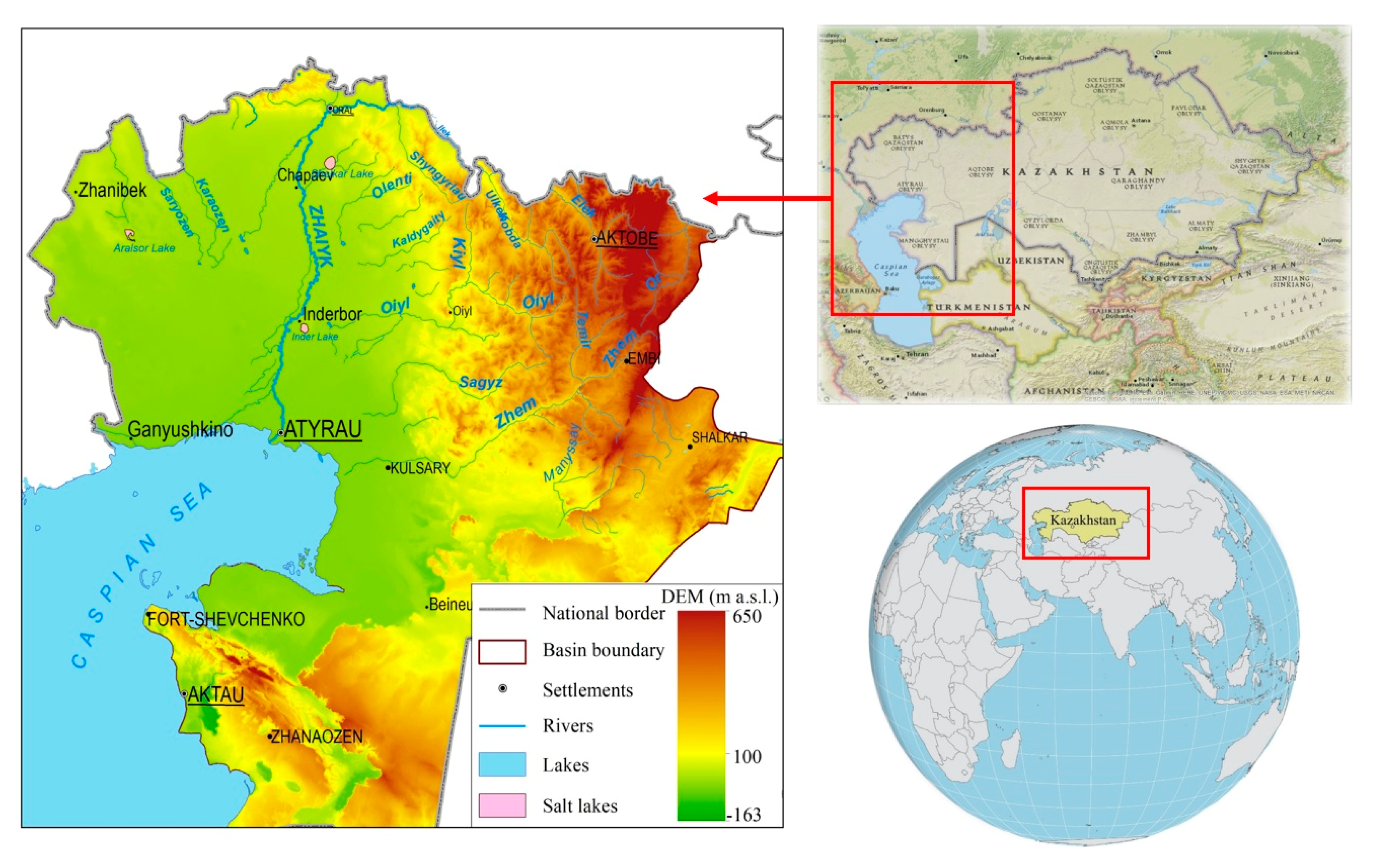
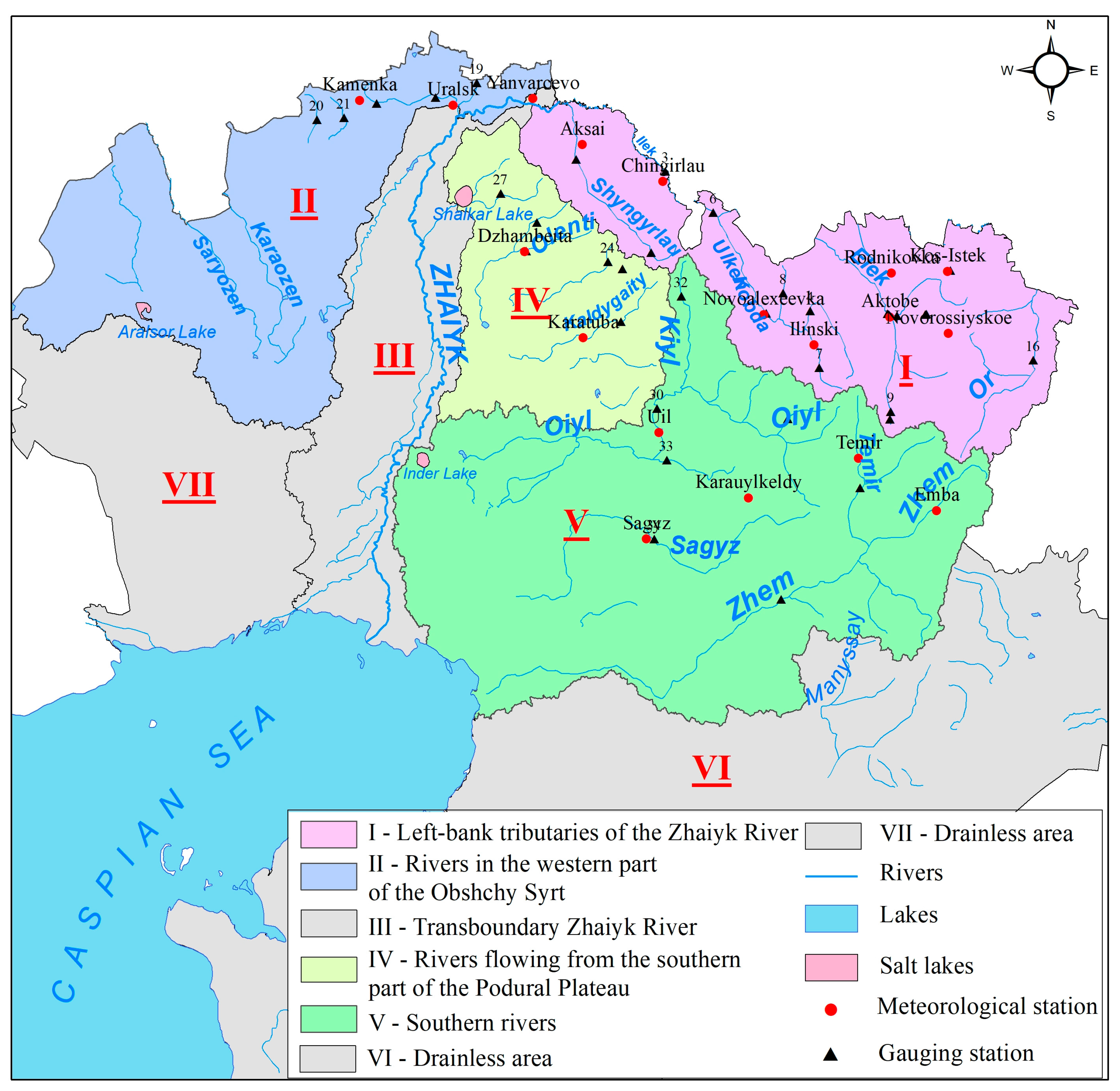
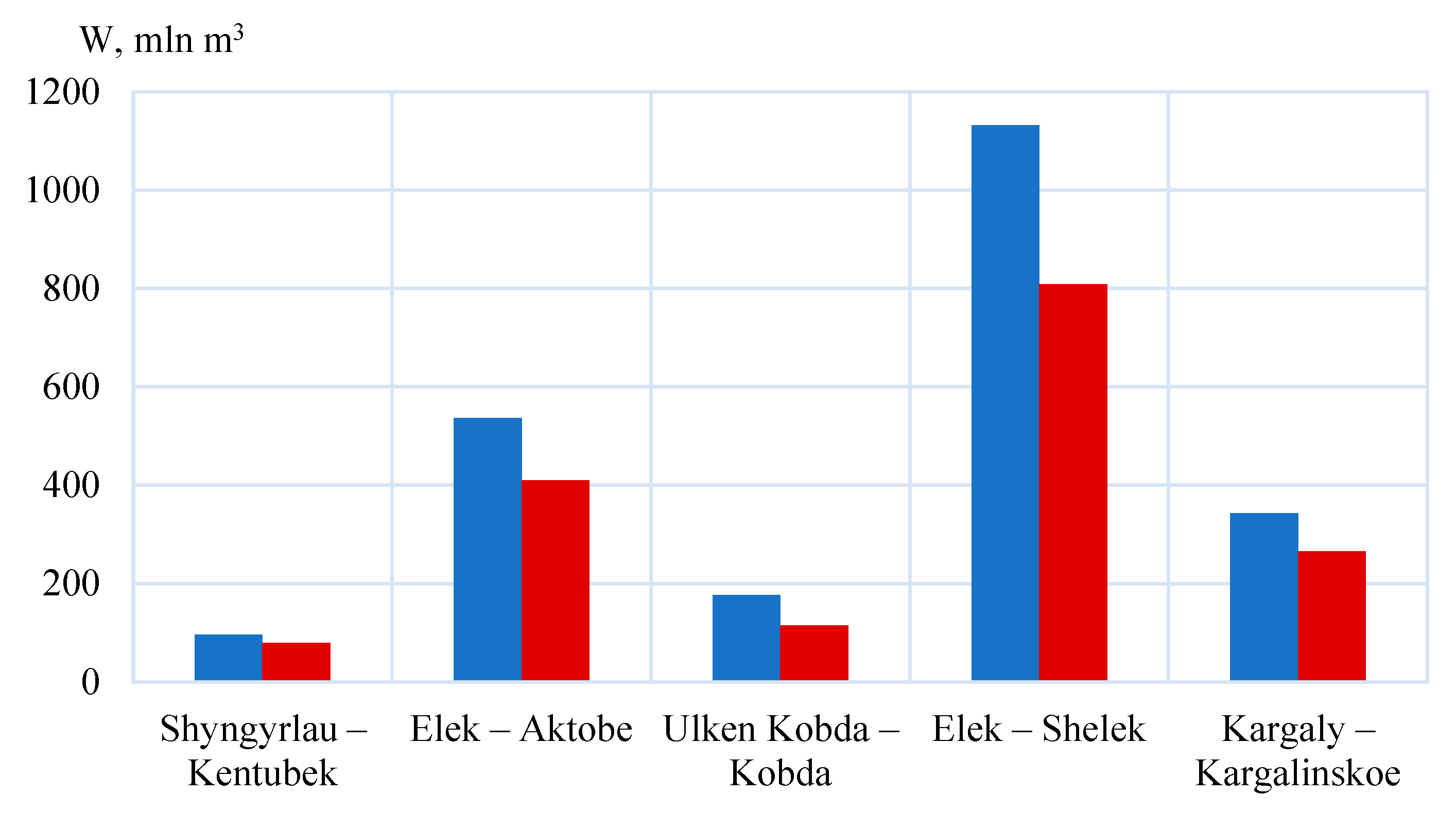
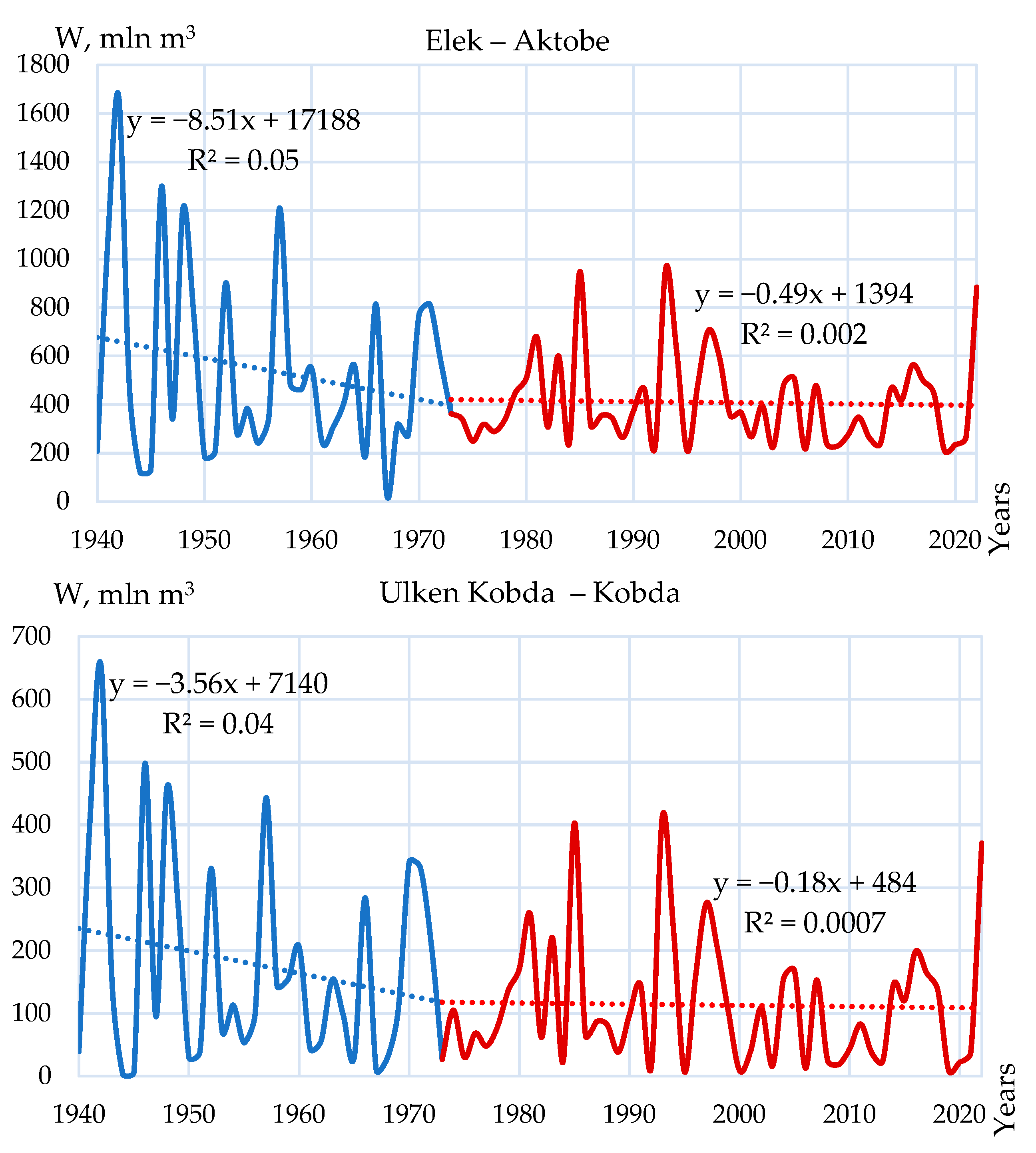
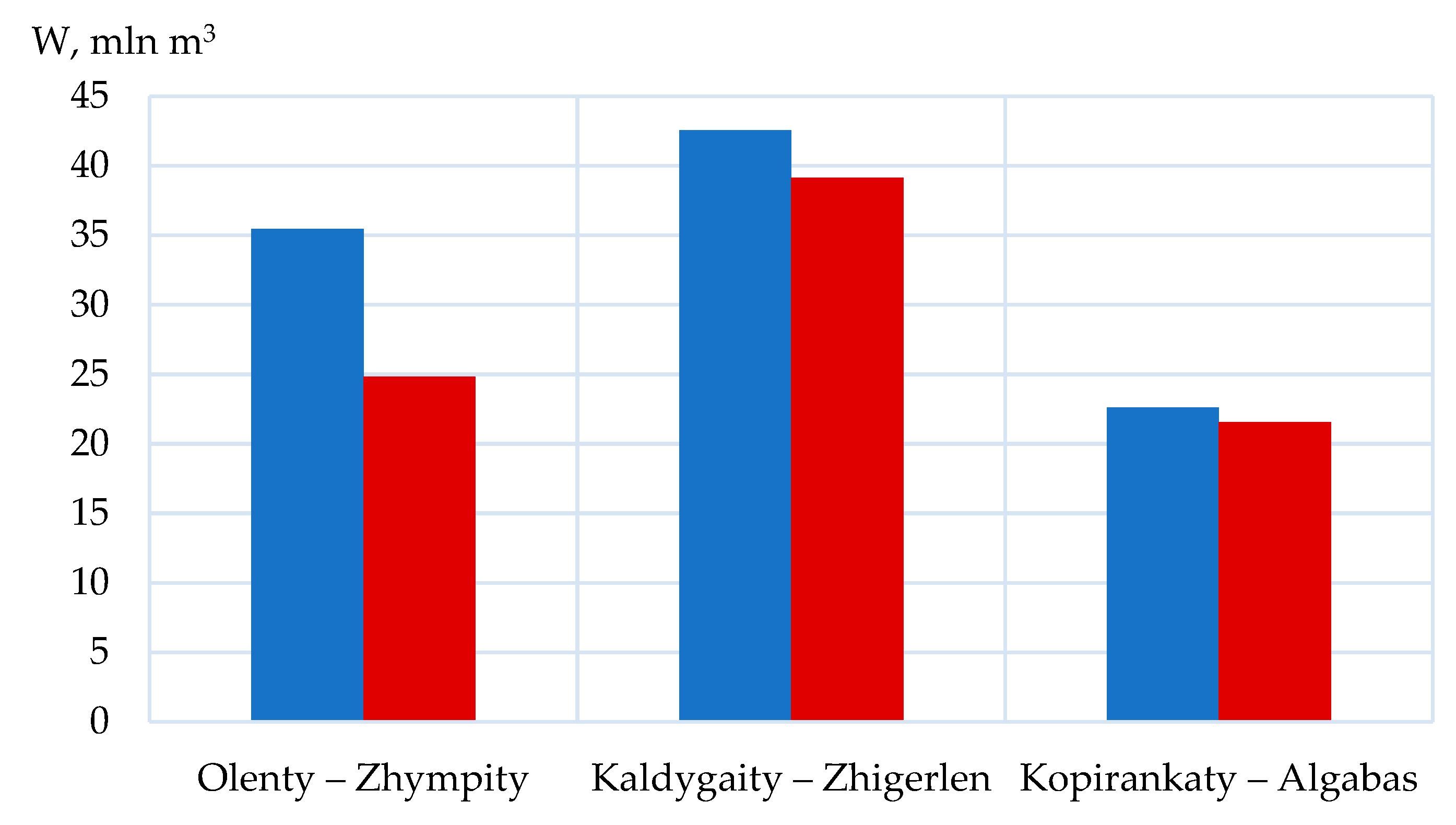
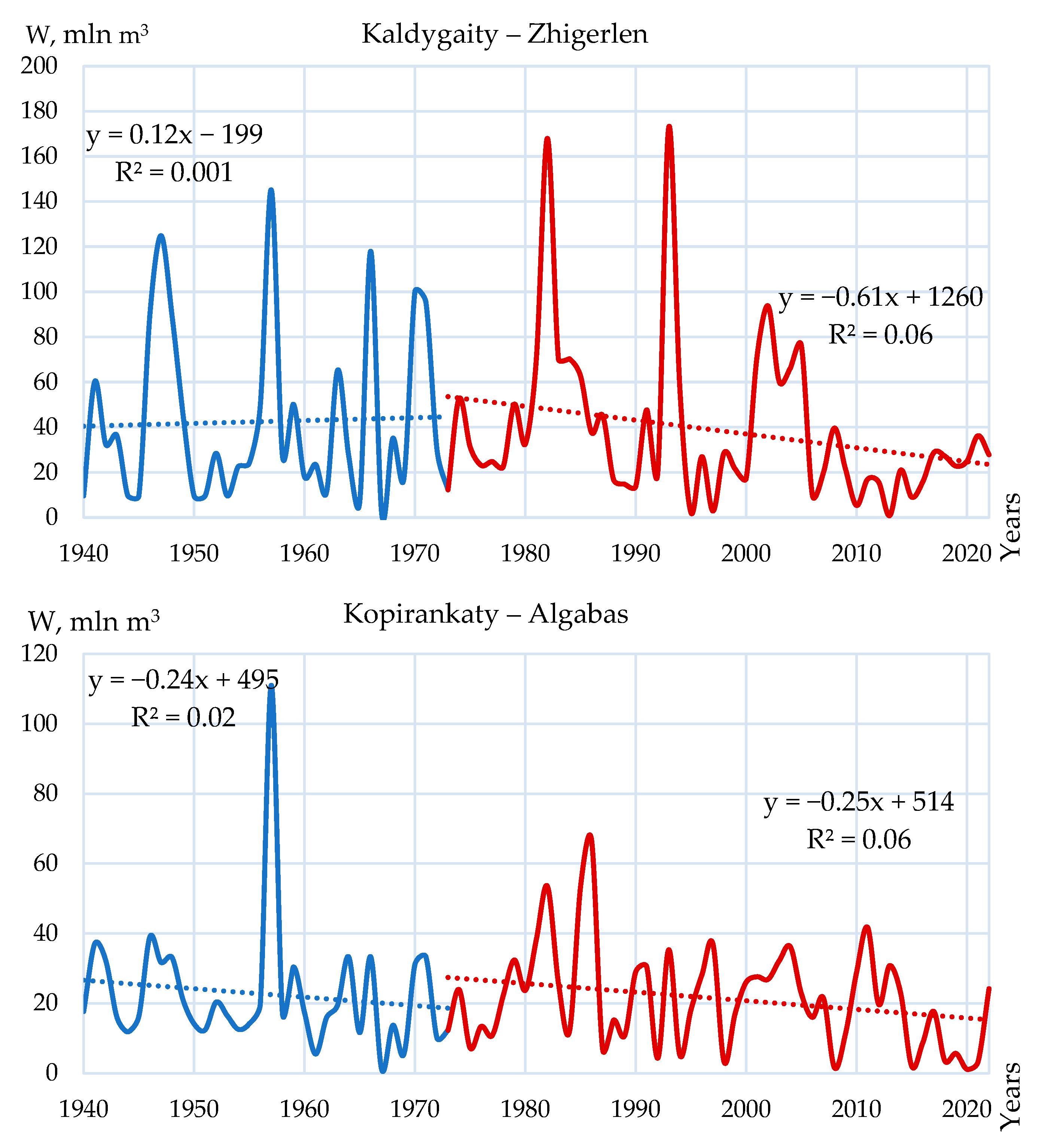
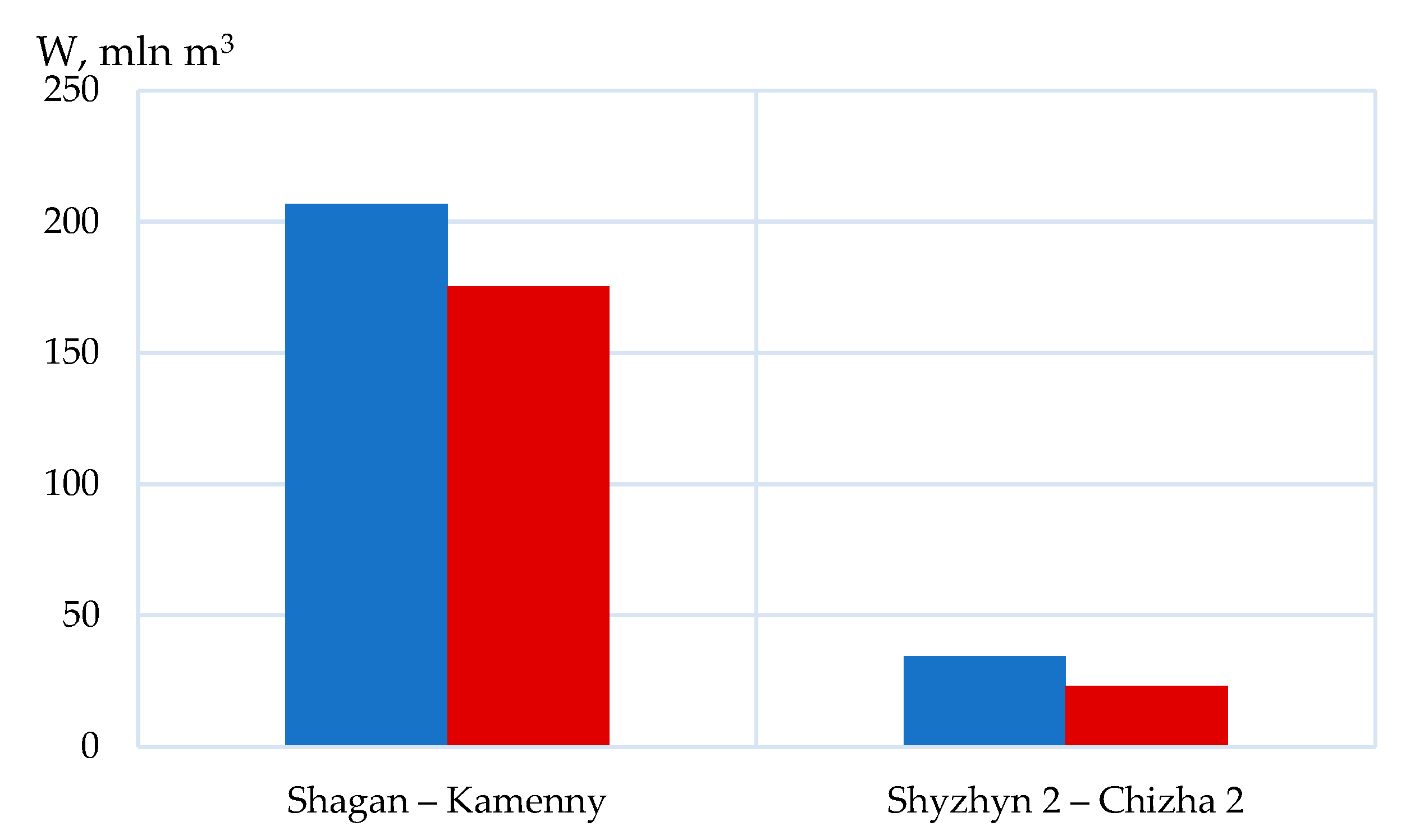
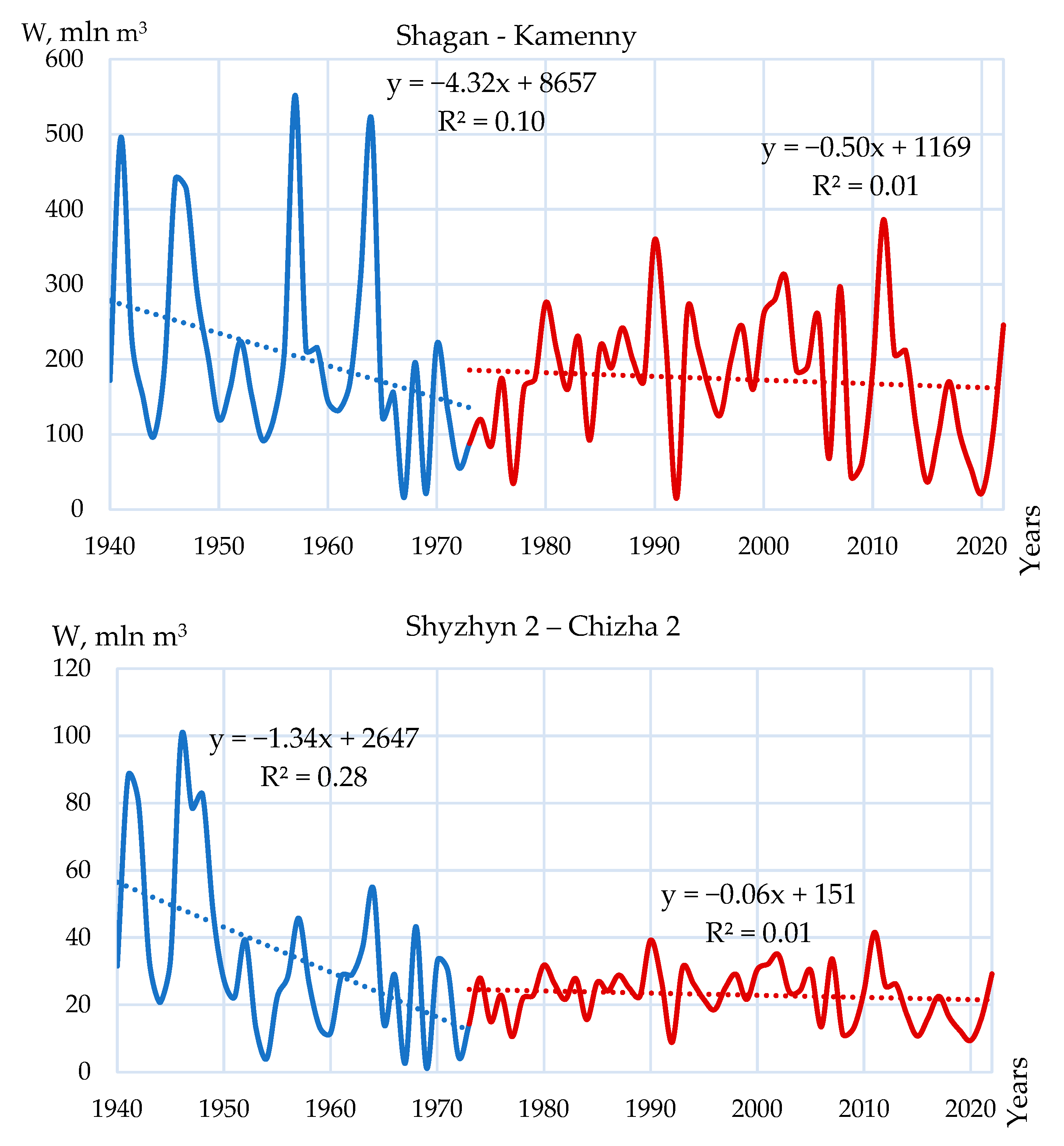
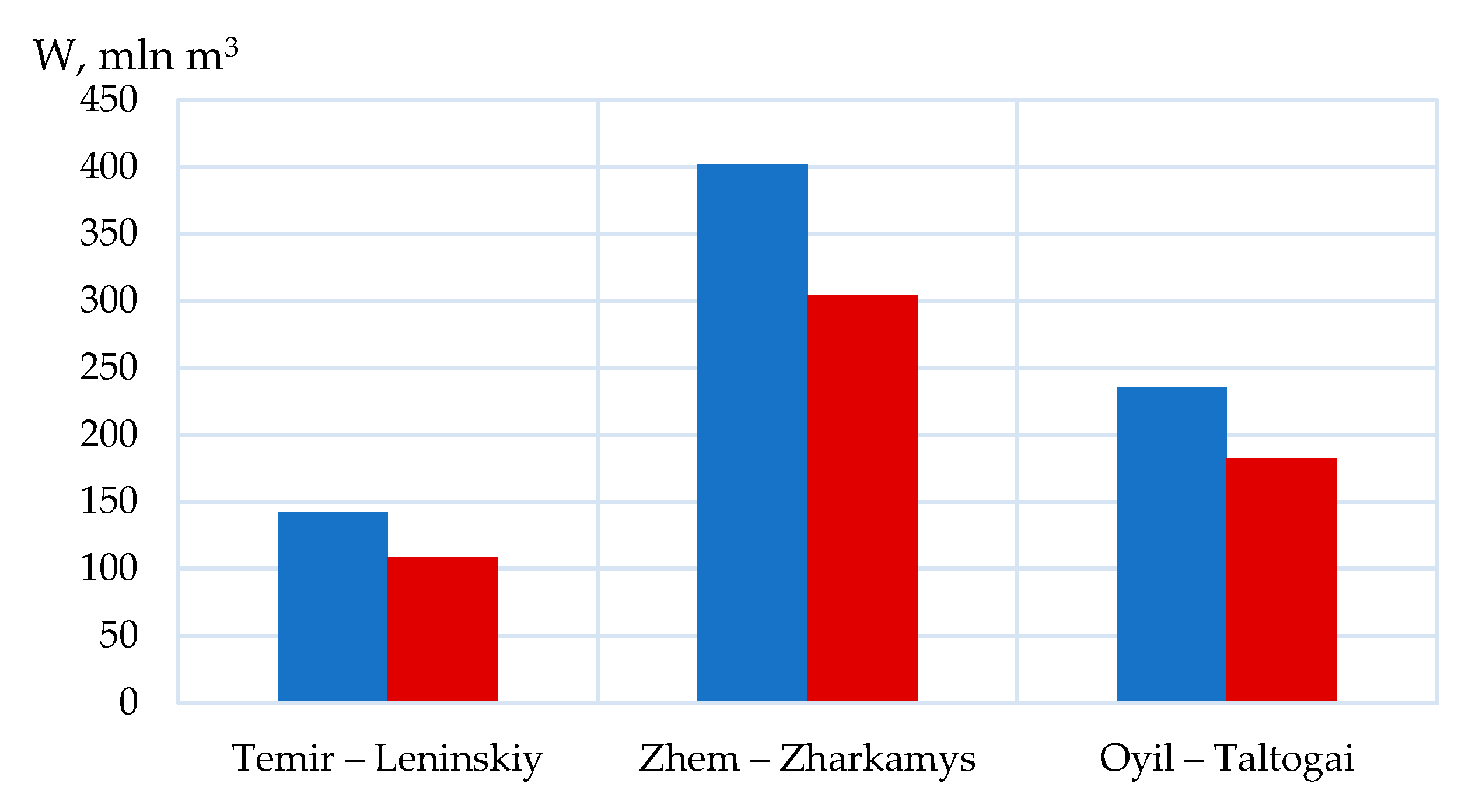
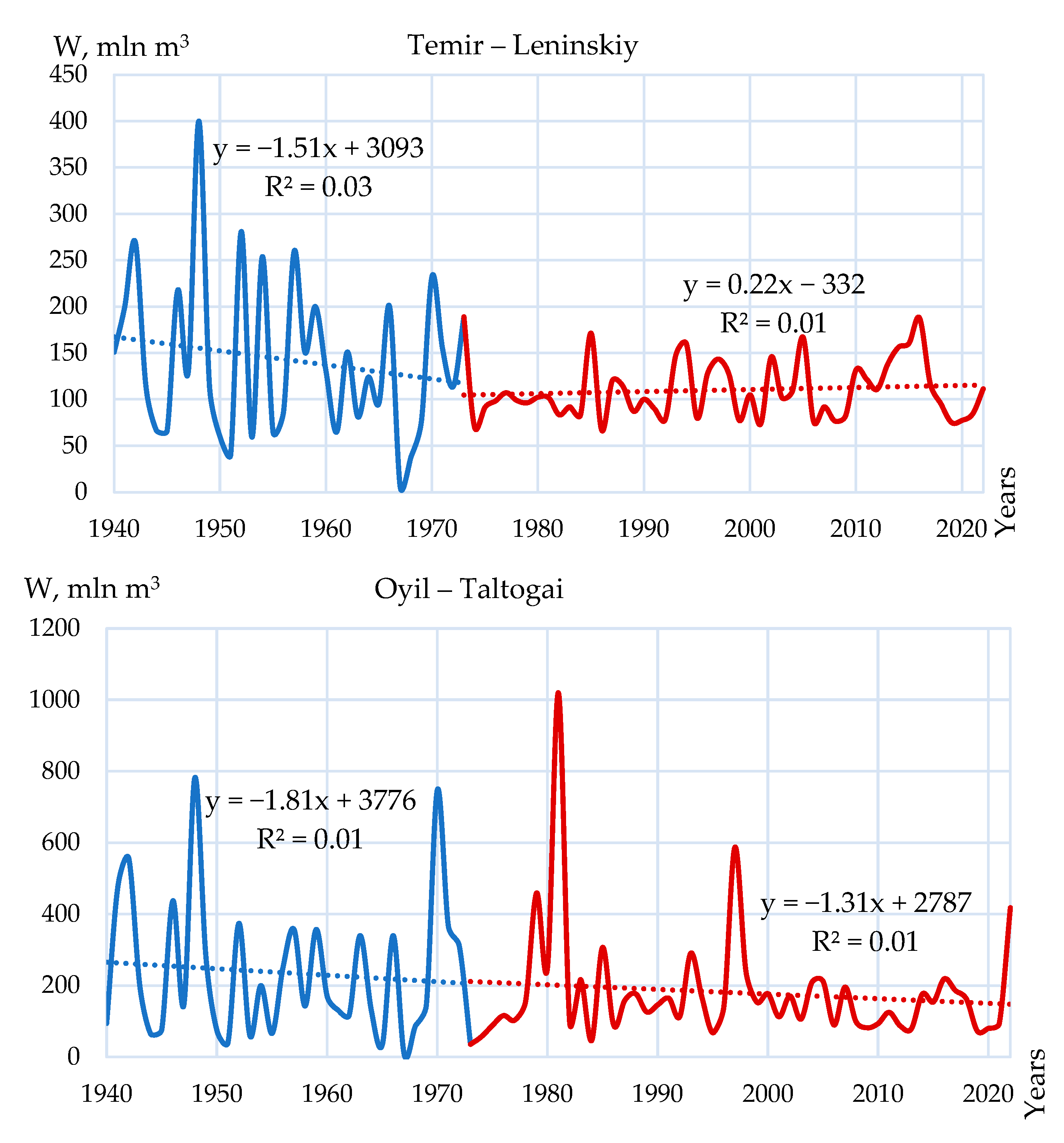
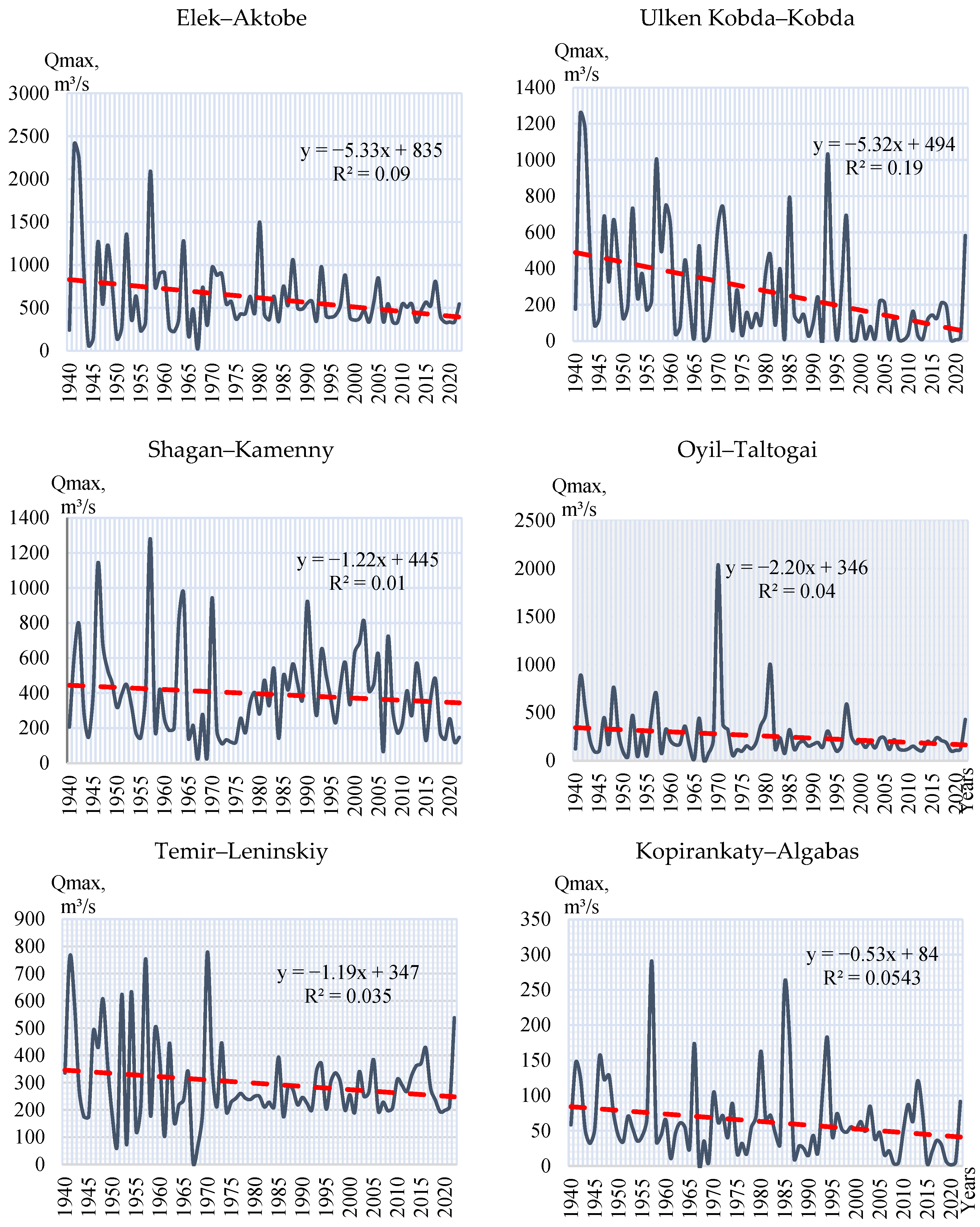
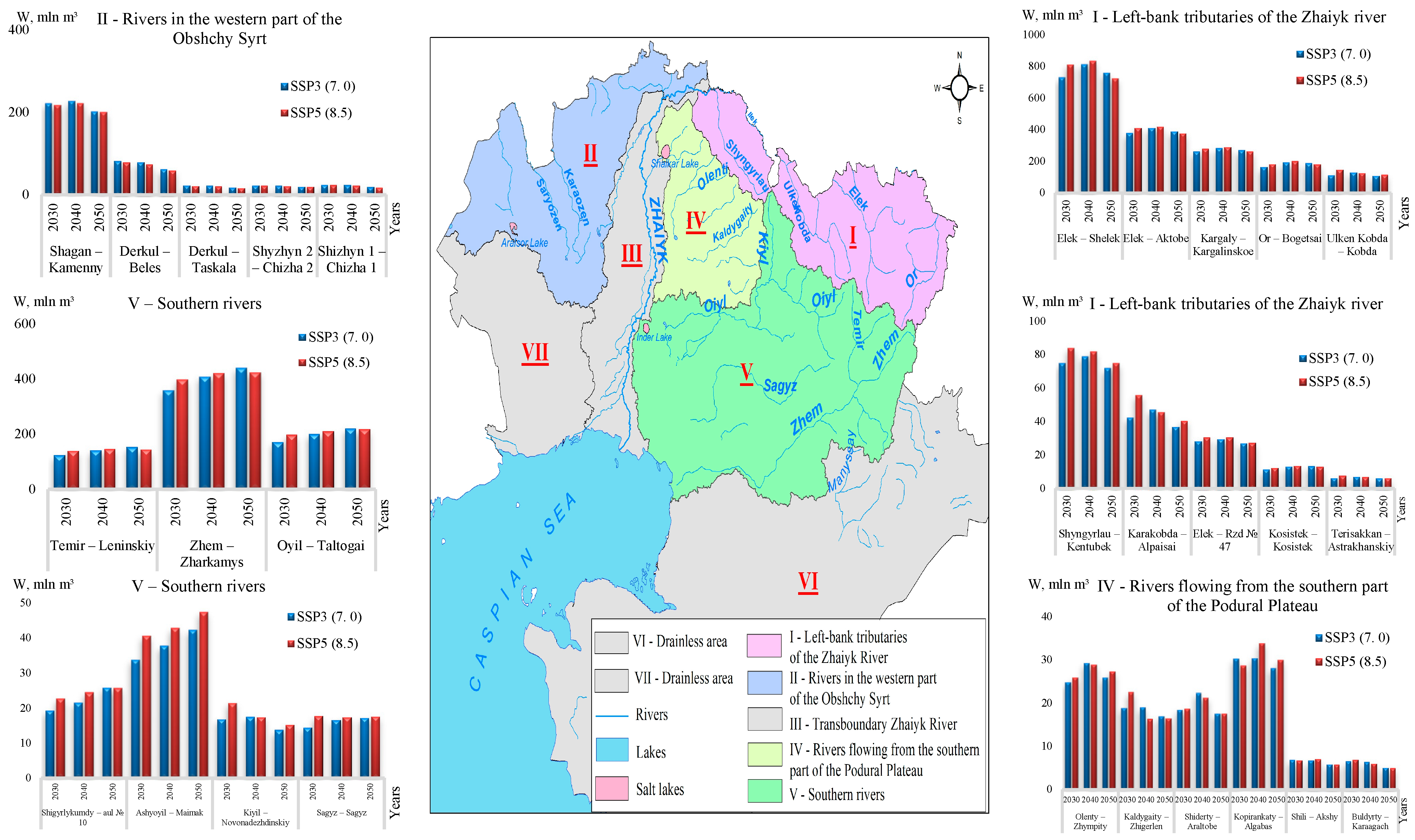


| № | Gauging Station | Observation Period | Watershed Area, km2 | Multi-Year Average Discharge, m3/s |
|---|---|---|---|---|
| I district—left-bank tributaries of the Zhaiyk River | ||||
| 1 | Shyngyrlau–Lubenka | 1963–present time | 641 | 0.40 |
| 2 | Shyngyrlau–Kentubek | 1940–present time | 4660 | 3.42 |
| 3 | Elek–Shelek | 1940–present time | 37,300 | 32.6 |
| 4 | Karakobda–Alpaisai | 1962–present time | 2240 | 2.32 |
| 5 | Ulken Kobda–Kobda | 1940–present time | 8110 | 4.84 |
| 6 | Ulken Kobda–Kogaly | 1980–present time | 14,200 | 7.84 |
| 7 | Sarykobda–Bessarabsky | 1956–1995 | 675 | 0.45 |
| 8 | Terisakkan–Astrakhanskiy | 1956–1995 | 446 | 0.38 |
| 9 | Elek–Rzd № 47 | 1950–1990 | 1090 | 1.12 |
| 10 | Karagandy–Kandagach | 1948–1989 | 222 | 0.26 |
| 11 | Kosestek–Kosestek | 1956–present time | 281 | 0.77 |
| 12 | Aktasty–Belogorskiy | 1946–present time | 45 | 0.17 |
| 13 | Terisbutak–Belogorskiy | 1946–1990 | 19.8 | 0.09 |
| 14 | Elek–Aktobe | 1938–present time | 11,000 | 14.8 |
| 15 | Kargaly–Kargalinskoe | 1940–present time | 5000 | 9.54 |
| 16 | Or–Bogetsai | 1956–present time | 7480 | 5.43 |
| II district—rivers of the western part of the Common Szyrt | ||||
| 17 | Derkul–Taskala | 1963–present time | 392 | 0.76 |
| 18 | Derkul–Beles | 1962–present time | 1820 | 4.38 |
| 19 | Shagan–Kamenny | 1931–2010 | 4000 | 8.80 |
| 20 | Shyzhyn 2–Chizha 2 | 1940–present time | 509 | 1.61 |
| 21 | Shizhyn 1–Chizha 1 | 1957–present time | 456 | 1.43 |
| IV district—rivers flowing from the southern part of the Pre-Urals plateau | ||||
| 22 | Olenty–Zhympity | 1940–present time | 1290 | 1.25 |
| 23 | Shiderty–Araltobe | 1963–present time | 750 | 0.81 |
| 24 | Buldurty–Karaagach | 1963–1990 | 457 | 0.43 |
| 25 | Kaldygaity–Zhigerlen | 1940–present time | 2510 | 1.72 |
| 26 | Shili–Akshy | 1956–1992 | 318 | 0.32 |
| 27 | Kopirankaty–Algabas | 1940–present time | 723 | 0.76 |
| V district—southern rivers | ||||
| 28 | Temir–Leninskiy | 1932–present time | 5310 | 3.84 |
| 29 | Zhem–Zharkamys | 1941–1991 | 26,000 | 10.8 |
| 30 | Oyil–Taltogai | 1936–1982 | 17,000 | 7.21 |
| 31 | Shigyrlykumdy–aul № 10 | 1956–1992 | 1110 | 0.64 |
| 32 | Kiyil–Novonadezhdinskiy | 1956–1998 | 720 | 0.79 |
| 33 | Ashyoyil–Maimak | 1956–1992 | 4900 | 0.94 |
| 34 | Sagyz–Sagyz | 1949–1998 | 9930 | 1.00 |
| № | Meteorological Station | Observation Period | Altitude Above Sea Level, m |
|---|---|---|---|
| I district—left-bank tributaries of the Zhaiyk River | |||
| 1 | Chingirlau | 1928–present time | 103 |
| 2 | Aksai | 1937–present time | 63 |
| 3 | Novoalexeevka | 1937–present time | 143 |
| 4 | Novorossiyskoe | 1925–present time | 415 |
| 5 | Ilinski | 1958–present time | 191 |
| 6 | Kos-Istek | 1956–present time | 338 |
| 7 | Rodnikovka | 1930–present time | 372 |
| 8 | Aktobe | 1898–present time | 219 |
| II district—rivers of the western part of the Common Szyrt | |||
| 9 | Kamenka | 1954–present time | 72 |
| 10 | Uralsk | 1888–present time | 35 |
| IV district—rivers flowing from the southern part of the Pre-Urals plateau | |||
| 11 | Dzhambeita | 1897–present time | 31 |
| 12 | Karatobe | 1958–present time | 44 |
| V district—southern rivers | |||
| 13 | Temir | 1894–present time | 234 |
| 14 | Emba | 1904–present time | 252 |
| 15 | Uil | 1886–present time | 95 |
| 16 | Karauylkeldy | 1937–present time | 200 |
| 17 | Sagyz | 1954–present time | 55 |
| № | River–Point | Meteorological Station | Calculation Dependencies |
|---|---|---|---|
| I—left-bank tributaries of the Zhaiyk River | |||
| 1 | Shyngyrlau | Novoalexeevka | |
| 2 | Elek, Or | Aktobe, Kos-Istek, Rodnikovka | |
| 3 | Kargaly, Kosestek, Terisbutak | Kos-Istek, Rodnikovka | |
| 4 | Ulken Kobda, Karakobda, Sarykobda, Terisakkan | Novoalexeevka, Ilinski | |
| II—rivers of the western part of the Obshchy Syrt | |||
| 1 | Derkul, Shyzhyn 2, Shizhyn 1 | Uralsk, Kamenka | |
| 2 | Shagan | Uralsk, Yanvartsevo | |
| IV—rivers flowing from the southern part of the Podural Plateau | |||
| 1 | Olenty | Dzhambeita, Karatobe | |
| 2 | Kopirankaty | Dzhambeita, Aksai | |
| 3 | Buldurty, Kaldygaity | Karatobe | |
| 4 | Shiderty | Dzhambeita, Karatobe, Aksai | |
| V—southern rivers | |||
| 1 | Temir, Zhem | Emba, Temir | |
| 2 | Sagyz | Sagyz, Karauylkeldy | |
| 3 | Oyil | Karauylkeldy, Uil, Temir | |
| 4 | Ashyoyil | Karauylkeldy, Uil | |
| 5 | Shigyrlykumdy | Karauylkeldy, Temir | |
| River–Point | Period | Flood Start Date, day | Flood End Date, days | Duration of Flood, day | Qmax, m3/s | Volume of Runoff During the Flood, mln. m3 |
|---|---|---|---|---|---|---|
| I district—left-bank tributaries of the Zhaiyk River | ||||||
| Ulken Kobda–Kobda | Before 1973 | 05/IV | 08/V | 34 | 411 | 176 |
| 1974–2022 | 28/III | 03/V | 37 | 175 | 115 | |
| Δ | −7 | −5 | +3 | −57% | −35% | |
| Elek–Aktobe | Before 1973 | 01/IV | 18/V | 49 | 736 | 537 |
| 1974–2022 | 31/III | 02/V | 33 | 525 | 410 | |
| Δ | −1 | −16 | −16 | −29% | −24% | |
| Aktasty–Belogorskiy | Before 1973 | 02/IV | 29/IV | 28 | 15 | 5.8 |
| 1974–2022 | 30/III | 23/IV | 25 | 10 | 3.9 | |
| Δ | −3 | −6 | −3 | −35% | −32% | |
| Kargaly–Kargalinskoe | Before 1973 | 06/IV | 14/V | 39 | 505 | 343 |
| 1974–2022 | 30/III | 29/IV | 32 | 386 | 266 | |
| Δ | −7 | −15 | −7 | −24% | −23% | |
| II district—rivers of the western part of the Obshchy Syrt | ||||||
| Shagan–Kamenny | Before 1973 | 02/IV | 06/V | 35 | 408 | 207 |
| 1974–2022 | 28/III | 01/V | 35 | 385 | 175 | |
| Δ | −5 | −5 | 0 | −6% | −15% | |
| Shyzhyn 2–Chizha 2 | Before 1973 | 30/III | 01/V | 33 | 79 | 34 |
| 1974–2022 | 26/III | 15/IV | 20 | 58 | 23 | |
| Δ | −4 | −15 | −12 | −26% | −33% | |
| IV district—rivers flowing from the southern part of the Podural Plateau | ||||||
| Kaldygaity–Zhigerlen | Before 1973 | 01/IV | 03/V | 33 | 123 | 43 |
| 1974–2022 | 25/III | 18/IV | 25 | 85 | 39 | |
| Δ | −7 | −14 | −8 | −31% | −8% | |
| Kopirankaty–Algabas | Before 1973 | 31/III | 30/IV | 31 | 71 | 23 |
| 1974–2022 | 26/III | 18/IV | 24 | 57 | 22 | |
| Δ | −5 | −12 | −7 | −20% | −5% | |
| V district—southern rivers | ||||||
| Temir–Leninskiy | Before 1973 | 01/IV | 04/V | 34 | 338 | 142 |
| 1974–2022 | 29/III | 28/IV | 32 | 269 | 109 | |
| Δ | −3 | −6 | −2 | −21% | −24% | |
| Oyil–Taltogai | Before 1973 | 01/IV | 12/V | 42 | 320 | 235 |
| 1974–2022 | 01/IV | 08/V | 38 | 209 | 182 | |
| Δ | 0 | −4 | −5 | −35% | −23% | |
| Zhem–Zharkamys | Before 1973 | 27/III | 14/V | 49 | 454 | 402 |
| 1974–2022 | 25/III | 02/V | 38 | 335 | 305 | |
| Δ | −2 | −13 | −10 | −26% | −24% | |
| № | Meteorological Station | Period | ΣP for Months IX–X, mm/10 years | ΣP for Months XI–III, mm/10 years | T av for Months VI–X °C/10 years | T av for Months XI–III °C/10 years | ΣT—(Negative Temperatures) for Months XII–III |
|---|---|---|---|---|---|---|---|
| 1 | Sagyz | 1961–2022 | −2.5 | 1.4 | 0.4 | 0.3 | 48.5 |
| 2 | Karatobe | 1959–2022 | −1.5 | 3.2 | 0.3 | 0.5 | 61.6 |
| 3 | Ilinski | 1960–2022 | −0.2 | −0.9 | 0.3 | 0.4 | 50.8 |
| 4 | Kos-Istek | 1958–2022 | −3.1 | 7.4 | 0.2 | 0.3 | 32.9 |
| 5 | Kamenka | 1956–2022 | −0.3 | −3.8 | 0.3 | 0.4 | 51.0 |
| 6 | Novorossiyskoe | 1961–2022 | −4.1 | −1.4 | 0.3 | 0.3 | 32.9 |
| 7 | Karauylkeldy | 1940–1973 | 2.6 | 19.0 | 0.2 | 0.2 | −8.3 |
| 1974–2022 | −0.1 | 10.4 | 0.4 | 0.4 | 53.5 | ||
| 1940–2022 | −1.1 | 6.7 | 0.3 | 0.4 | 47.1 | ||
| 8 | Emba | 1940–1973 | 4.2 | 24.0 | 0.0 | 0.2 | −7.3 |
| 1974–2022 | −1.7 | −2.4 | 0.2 | 0.3 | 37.9 | ||
| 1940–2022 | −1.6 | 3.8 | 0.2 | 0.3 | 37.6 | ||
| 9 | Uil | 1940–1973 | 2.2 | 24.2 | 0.0 | 0.2 | 3.1 |
| 1974–2022 | 0.5 | 5.2 | 0.4 | 0.5 | 65.7 | ||
| 1940–2022 | −1.4 | 3.9 | 0.2 | 0.4 | 49.5 | ||
| 10 | Temir | 1951–1973 | −0.5 | 16.9 | −0.2 | 0.5 | −5.9 |
| 1974–2022 | −3.2 | −1.5 | 0.3 | 0.4 | 55.2 | ||
| 1951–2022 | −2.9 | 3.9 | 0.2 | 0.5 | 57.1 | ||
| 11 | Novoalexeevka | 1940–1973 | −0.5 | 12.8 | 0.1 | 0.1 | −24.8 |
| 1974–2022 | −2.5 | −2.2 | 0.4 | 0.6 | 51.2 | ||
| 1940–2022 | −1.7 | 7.2 | 0.2 | 0.4 | 43.7 | ||
| 12 | Dzhambeita | 1940–1973 | −5.7 | 19.7 | 0.2 | 0.2 | −21.7 |
| 1974–2022 | 1.2 | −3.9 | 0.4 | 0.5 | 58.9 | ||
| 1940–2022 | −2.3 | 1.2 | 0.2 | 0.5 | 56.4 | ||
| 13 | Aktobe | 1940–1973 | −0.5 | 19.7 | 0.2 | 0.5 | 29.1 |
| 1974–2022 | −1.6 | 5.1 | 0.4 | 0.5 | 53.1 | ||
| 1940–2022 | −1.2 | 11.8 | 0.2 | 0.5 | 57.6 | ||
| 14 | Rodnikovka | 1940–1973 | 8.0 | 40.5 | 0.0 | 0.3 | 3.8 |
| 1974–2022 | −4.6 | −4.3 | 0.4 | 0.4 | 48.6 | ||
| 1940–2022 | −4.3 | 5.5 | 0.3 | 0.4 | 44.3 | ||
| 15 | Aksai | 1940–1973 | −2.7 | 13.6 | 0.2 | 0.5 | 32.5 |
| 1974–2022 | −0.04 | 9.3 | 0.4 | 0.5 | 62.0 | ||
| 1940–2022 | −1.5 | 7.8 | 0.2 | 0.5 | 60.4 | ||
| 16 | Uralsk | 1940–1973 | −2.9 | 20.5 | 0.2 | 0.4 | −2.1 |
| 1974–2022 | −0.7 | 2.1 | 0.5 | 0.5 | 52.1 | ||
| 1940–2022 | 0.05 | 5.6 | 0.2 | 0.5 | 55.6 | ||
| 17 | Chingirlau | 1940–1973 | −3.6 | 15.9 | 0.2 | 0.3 | 11.3 |
| 1974–2022 | −0.9 | −1.9 | 0.5 | 0.4 | 47.0 | ||
| 1940–2022 | −2.4 | 4.3 | 0.2 | 0.4 | 50.2 |
| Meteorological Station | Periods | Number of Thaw Events with Duration | ||||
|---|---|---|---|---|---|---|
| 0–5 Days | 6–10 Days | 11–15 Days | 16–20 Days | 20–30 Days | ||
| Aksai | 1940–1973 | 15 | 9 | 7 | 4 | 0 |
| 1974–2022 | 8 | 16 | 13 | 8 | 1 | |
| Uralsk | 1940–1973 | 11 | 8 | 7 | 4 | 4 |
| 1974–2022 | 8 | 7 | 9 | 11 | 11 | |
| Chingirlau | 1940–1973 | 13 | 7 | 7 | 1 | 4 |
| 1974–2022 | 10 | 17 | 7 | 3 | 8 | |
| Chapaevo | 1940–1973 | 11 | 5 | 7 | 4 | 7 |
| 1974–2022 | 6 | 7 | 14 | 7 | 13 | |
| Aktobe | 1940–1973 | 15 | 7 | 5 | 4 | 2 |
| 1974–2022 | 11 | 15 | 11 | 8 | 3 | |
| Martuk | 1940–1973 | 15 | 7 | 9 | 1 | 2 |
| 1974–2022 | 13 | 14 | 10 | 6 | 4 | |
| Novoalexeevka | 1940–1973 | 11 | 9 | 5 | 3 | 5 |
| 1974–2022 | 12 | 8 | 11 | 8 | 8 | |
| Uil | 1936–1973 | 16 | 9 | 9 | 3 | 0 |
| 1974–2022 | 16 | 14 | 11 | 3 | 3 | |
| Karauylkeldy | 1940–1973 | 18 | 9 | 5 | 3 | 0 |
| 1974–2022 | 12 | 19 | 12 | 4 | 0 | |
| Hydrological Districts | Meteorological Station | SSP Scenarios | Periods | Change in °C from the 1991–2020 Baseline Period | |||||
|---|---|---|---|---|---|---|---|---|---|
| 1991–2020 | 2030 (2026–2035) | 2040 (2036–2045) | 2050 (2046–2055) | ||||||
| I district | Novorossiyskoe | 3–7.0 | 15.7 | 17.6 | 18.3 | 18.7 | 1.9 | 2.6 | 3.1 |
| 5–8.5 | 17.8 | 18.6 | 18.8 | 2.1 | 2.9 | 3.1 | |||
| Aktobe | 3–7.0 | 17.1 | 18.7 | 19.3 | 19.9 | 1.6 | 2.2 | 2.8 | |
| 5–8.5 | 18.8 | 19.5 | 20.0 | 1.7 | 2.4 | 2.9 | |||
| Kos-Istek | 3–7.0 | 14.9 | 18.1 | 18.8 | 19.3 | 3.2 | 3.8 | 4.4 | |
| 5–8.5 | 18.2 | 18.9 | 19.4 | 3.3 | 4.0 | 4.4 | |||
| Rodnikovka | 3–7.0 | 15.5 | 18.0 | 18.7 | 19.2 | 2.5 | 3.2 | 3.6 | |
| 5–8.5 | 18.2 | 18.9 | 19.4 | 2.6 | 3.3 | 3.8 | |||
| Novoalexeevka | 3–7.0 | 17.6 | 19.4 | 20.1 | 20.6 | 1.8 | 2.4 | 3.0 | |
| 5–8.5 | 19.6 | 20.3 | 20.8 | 2.0 | 2.6 | 3.1 | |||
| Aksai | 3–7.0 | 17.3 | 19.3 | 19.9 | 20.4 | 2.0 | 2.7 | 3.1 | |
| 5–8.5 | 19.5 | 20.1 | 20.6 | 2.2 | 2.9 | 3.4 | |||
| Chingirlau | 3–7.0 | 17.5 | 19.1 | 19.8 | 20.2 | 1.6 | 2.3 | 2.7 | |
| 5–8.5 | 19.3 | 19.9 | 20.4 | 1.8 | 2.5 | 3.0 | |||
| II district | Kamenka | 3–7.0 | 16.9 | 19.2 | 19.9 | 20.4 | 2.3 | 3.0 | 3.5 |
| 5–8.5 | 19.4 | 20.1 | 20.6 | 2.5 | 3.2 | 3.7 | |||
| Yanvartsevo | 3–7.0 | 17.2 | 19.3 | 20.0 | 20.5 | 2.2 | 2.9 | 3.4 | |
| 5–8.5 | 19.6 | 20.2 | 20.6 | 2.4 | 3.1 | 3.4 | |||
| Uralsk | 3–7.0 | 17.4 | 19.2 | 19.9 | 20.4 | 1.8 | 2.5 | 3.0 | |
| 5–8.5 | 19.5 | 20.1 | 20.6 | 2.1 | 2.7 | 3.2 | |||
| IV district | Dzhambeita | 3–7.0 | 18.3 | 20.2 | 20.9 | 21.4 | 1.9 | 2.6 | 3.1 |
| 5–8.5 | 20.4 | 21.1 | 21.6 | 2.1 | 2.7 | 3.3 | |||
| Karatobe | 3–7.0 | 18.4 | 20.9 | 21.6 | 22.1 | 2.5 | 3.1 | 3.7 | |
| 5–8.5 | 21.1 | 21.7 | 22.3 | 2.7 | 3.3 | 3.9 | |||
| V district | Emba | 3–7.0 | 18.2 | 18.8 | 19.5 | 20.0 | 0.7 | 1.3 | 1.9 |
| 5–8.5 | 19.0 | 19.6 | 20.1 | 0.8 | 1.5 | 1.9 | |||
| Temir | 3–7.0 | 17.9 | 19.2 | 19.9 | 20.5 | 1.4 | 2.0 | 2.6 | |
| 5–8.5 | 19.4 | 20.0 | 20.5 | 1.5 | 2.2 | 2.6 | |||
| Karauylkeldy | 3–7.0 | 19.9 | 20.4 | 21.0 | 21.6 | 0.6 | 1.2 | 1.8 | |
| 5–8.5 | 20.6 | 21.2 | 21.8 | 0.7 | 1.4 | 1.9 | |||
| Sagyz | 3–7.0 | 20.2 | 20.8 | 21.4 | 22.0 | 0.6 | 1.2 | 1.8 | |
| 5–8.5 | 21.0 | 21.6 | 22.2 | 0.7 | 1.4 | 1.9 | |||
| Uil | 3–7.0 | 19.2 | 20.5 | 21.1 | 21.7 | 1.4 | 2.0 | 2.5 | |
| 5–8.5 | 20.7 | 21.3 | 21.9 | 1.6 | 2.2 | 2.7 | |||
| Hydrological Districts | Meteorological Station | SSP Scenarios | Periods | Change in mm from the 1991–2020 Baseline Period | |||||
|---|---|---|---|---|---|---|---|---|---|
| 1991–2020 | 2030 (2026–2035) | 2040 (2036–2045) | 2050 (2046–2055) | ||||||
| I district | Novorossiyskoe | 3–7.0 | 195 | 256 | 279 | 283 | 31 | 43 | 45 |
| 5–8.5 | 264 | 285 | 288 | 35 | 46 | 47 | |||
| Aktobe | 3–7.0 | 180 | 198 | 226 | 234 | 10 | 26 | 30 | |
| 5–8.5 | 215 | 232 | 230 | 20 | 29 | 28 | |||
| Kos-Istek | 3–7.0 | 213 | 237 | 275 | 284 | 11 | 29 | 33 | |
| 5–8.5 | 254 | 279 | 266 | 19 | 31 | 25 | |||
| Rodnikovka | 3–7.0 | 198 | 268 | 288 | 282 | 36 | 46 | 43 | |
| 5–8.5 | 275 | 296 | 288 | 39 | 50 | 46 | |||
| Novoalexeevka | 3–7.0 | 165 | 199 | 222 | 222 | 21 | 35 | 34 | |
| 5–8.5 | 224 | 226 | 222 | 36 | 37 | 35 | |||
| Aksai | 3–7.0 | 159 | 188 | 191 | 182 | 18 | 20 | 14 | |
| 5–8.5 | 179 | 206 | 193 | 13 | 30 | 21 | |||
| Chingirlau | 3–7.0 | 156 | 190 | 204 | 200 | 22 | 31 | 28 | |
| 5–8.5 | 196 | 215 | 212 | 26 | 38 | 36 | |||
| II district | Kamenka | 3–7.0 | 170 | 162 | 163 | 157 | −5 | −4 | −7 |
| 5–8.5 | 161 | 161 | 155 | −5 | −5 | −9 | |||
| Yanvartsevo | 3–7.0 | 200 | 233 | 246 | 249 | 17 | 23 | 25 | |
| 5–8.5 | 250 | 254 | 245 | 25 | 27 | 23 | |||
| Uralsk | 3–7.0 | 189 | 234 | 241 | 227 | 24 | 27 | 20 | |
| 5–8.5 | 230 | 237 | 226 | 21 | 25 | 20 | |||
| IV district | Dzhambeita | 3–7.0 | 135 | 178 | 194 | 179 | 32 | 44 | 33 |
| 5–8.5 | 180 | 193 | 186 | 33 | 43 | 38 | |||
| Karatobe | 3–7.0 | 137 | 159 | 172 | 170 | 16 | 26 | 24 | |
| 5–8.5 | 166 | 172 | 173 | 21 | 26 | 26 | |||
| V district | Emba | 3–7.0 | 118 | 140 | 170 | 190 | 19 | 44 | 61 |
| 5–8.5 | 160 | 175 | 172 | 36 | 49 | 46 | |||
| Temir | 3–7.0 | 163 | 179 | 212 | 233 | 10 | 30 | 43 | |
| 5–8.5 | 207 | 223 | 229 | 27 | 37 | 40 | |||
| Karauylkeldy | 3–7.0 | 123 | 144 | 169 | 182 | 17 | 38 | 48 | |
| 5–8.5 | 174 | 179 | 188 | 42 | 46 | 53 | |||
| Sagyz | 3–7.0 | 92 | 122 | 138 | 145 | 32 | 49 | 57 | |
| 5–8.5 | 140 | 143 | 147 | 52 | 55 | 59 | |||
| Uil | 3–7.0 | 145 | 173 | 185 | 201 | 19 | 28 | 39 | |
| 5–8.5 | 191 | 191 | 195 | 32 | 32 | 34 | |||
| Hydrological Districts | Meteorological Station | SSP Scenarios | Periods | Change in °C from the 1991–2020 Baseline Period | |||||
|---|---|---|---|---|---|---|---|---|---|
| 1991–2020 | 2030 (2026–2035) | 2040 (2036–2045) | 2050 (2046–2055) | ||||||
| I district | Novorossiyskoe | 3–7.0 | −9.8 | −8.1 | −7.4 | −6.6 | 1.8 | 2.5 | 3.3 |
| 5–8.5 | −8.1 | −7.3 | −7.0 | 1.8 | 2.5 | 2.8 | |||
| Aktobe | 3–7.0 | −8.3 | −6.8 | −5.9 | −5.3 | 1.5 | 2.3 | 2.9 | |
| 5–8.5 | −6.8 | −5.9 | −5.4 | 1.4 | 2.4 | 2.8 | |||
| Kos-Istek | 3–7.0 | −9.8 | −7.7 | −6.9 | −6.3 | 2.0 | 2.8 | 3.4 | |
| 5–8.5 | −7.8 | −6.9 | −6.4 | 1.9 | 2.9 | 3.4 | |||
| Rodnikovka | 3–7.0 | −9.2 | −7.2 | −6.4 | −5.8 | 2.0 | 2.8 | 3.4 | |
| 5–8.5 | −7.3 | −6.3 | −5.9 | 1.9 | 2.8 | 3.2 | |||
| Novoalexeevka | 3–7.0 | −7.7 | −5.8 | −5.0 | −4.4 | 1.9 | 2.7 | 3.4 | |
| 5–8.5 | −5.9 | −5.0 | −4.5 | 1.8 | 2.7 | 3.3 | |||
| Aksai | 3–7.0 | −7.1 | −5.4 | −4.7 | −4.0 | 1.7 | 2.4 | 3.2 | |
| 5–8.5 | −5.6 | −4.6 | −4.1 | 1.5 | 2.5 | 3.0 | |||
| Chingirlau | 3–7.0 | −7.5 | −5.7 | −5.0 | −4.3 | 1.8 | 2.5 | 3.2 | |
| 5–8.5 | −5.9 | −4.9 | −4.4 | 1.6 | 2.5 | 3.1 | |||
| II district | Kamenka | 3–7.0 | −7.0 | −4.7 | −4.1 | −3.4 | 2.3 | 3.0 | 3.6 |
| 5–8.5 | −5.0 | −3.9 | −3.4 | 2.0 | 3.1 | 3.7 | |||
| Yanvartsevo | 3–7.0 | −7.0 | −6.0 | −5.2 | −4.5 | 1.0 | 1.8 | 2.5 | |
| 5–8.5 | −6.0 | −5.2 | −4.8 | 1.0 | 1.8 | 2.2 | |||
| Uralsk | 3–7.0 | −6.7 | −5.0 | −4.4 | −3.6 | 1.6 | 2.3 | 3.0 | |
| 5–8.5 | −5.3 | −4.3 | −3.7 | 1.4 | 2.4 | 2.9 | |||
| IV district | Dzhambeita | 3–7.0 | −6.5 | −4.5 | −3.8 | −3.1 | 2.0 | 2.7 | 3.4 |
| 5–8.5 | −4.7 | −3.8 | −3.1 | 1.8 | 2.8 | 3.4 | |||
| Karatobe | 3–7.0 | −6.3 | −4.2 | −3.4 | −2.9 | 2.1 | 2.9 | 3.4 | |
| 5–8.5 | −4.3 | −3.3 | −2.9 | 2.0 | 3.0 | 3.4 | |||
| V district | Emba | 3–7.0 | −8.1 | −7.0 | −6.1 | −5.6 | 1.2 | 2.0 | 2.6 |
| 5–8.5 | −7.0 | −6.1 | −5.7 | 1.1 | 2.1 | 2.5 | |||
| Temir | 3–7.0 | −7.9 | −6.3 | −5.5 | −5.0 | 1.5 | 2.4 | 2.9 | |
| 5–8.5 | −6.3 | −5.4 | −5.0 | 1.5 | 2.5 | 2.8 | |||
| Karauylkeldy | 3–7.0 | −6.8 | −4.7 | −3.8 | −3.3 | 2.1 | 3.0 | 3.5 | |
| 5–8.5 | −4.6 | −3.7 | −3.3 | 2.2 | 3.1 | 3.5 | |||
| Sagyz | 3–7.0 | −5.7 | −4.3 | −3.3 | −2.9 | 1.4 | 2.4 | 2.8 | |
| 5–8.5 | −4.2 | −3.3 | −2.9 | 1.5 | 2.4 | 2.8 | |||
| Uil | 3–7.0 | −6.3 | −4.7 | −3.9 | −3.4 | 1.6 | 2.3 | 2.9 | |
| 5–8.5 | −4.8 | −3.8 | −3.4 | 1.5 | 2.4 | 2.9 | |||
Disclaimer/Publisher’s Note: The statements, opinions and data contained in all publications are solely those of the individual author(s) and contributor(s) and not of MDPI and/or the editor(s). MDPI and/or the editor(s) disclaim responsibility for any injury to people or property resulting from any ideas, methods, instructions or products referred to in the content. |
© 2025 by the authors. Licensee MDPI, Basel, Switzerland. This article is an open access article distributed under the terms and conditions of the Creative Commons Attribution (CC BY) license (https://creativecommons.org/licenses/by/4.0/).
Share and Cite
Alimkulov, S.; Makhmudova, L.; Davletgaliev, S.; Talipova, E.; Snow, D.; Birimbayeva, L.; Dyldaev, M.; Smagulov, Z.; Sailaubek, A. Current Trends and Future Scenarios: Modeling Maximum River Discharge in the Zhaiyk–Caspian Basin (Kazakhstan) Under a Changing Climate. Hydrology 2025, 12, 278. https://doi.org/10.3390/hydrology12110278
Alimkulov S, Makhmudova L, Davletgaliev S, Talipova E, Snow D, Birimbayeva L, Dyldaev M, Smagulov Z, Sailaubek A. Current Trends and Future Scenarios: Modeling Maximum River Discharge in the Zhaiyk–Caspian Basin (Kazakhstan) Under a Changing Climate. Hydrology. 2025; 12(11):278. https://doi.org/10.3390/hydrology12110278
Chicago/Turabian StyleAlimkulov, Sayat, Lyazzat Makhmudova, Saken Davletgaliev, Elmira Talipova, Daniel Snow, Lyazzat Birimbayeva, Mirlan Dyldaev, Zhanibek Smagulov, and Akgulim Sailaubek. 2025. "Current Trends and Future Scenarios: Modeling Maximum River Discharge in the Zhaiyk–Caspian Basin (Kazakhstan) Under a Changing Climate" Hydrology 12, no. 11: 278. https://doi.org/10.3390/hydrology12110278
APA StyleAlimkulov, S., Makhmudova, L., Davletgaliev, S., Talipova, E., Snow, D., Birimbayeva, L., Dyldaev, M., Smagulov, Z., & Sailaubek, A. (2025). Current Trends and Future Scenarios: Modeling Maximum River Discharge in the Zhaiyk–Caspian Basin (Kazakhstan) Under a Changing Climate. Hydrology, 12(11), 278. https://doi.org/10.3390/hydrology12110278









